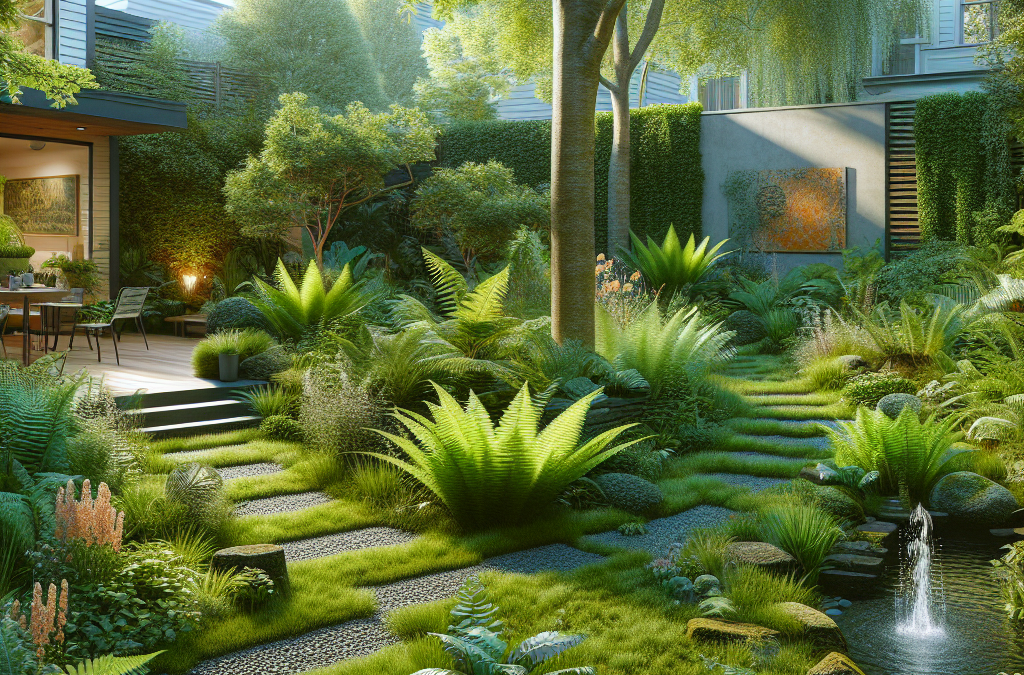Welcome to the world of Portland backyard design, where creativity meets functionality to create stunning outdoor spaces. Portland is renowned for its lush landscapes and unique climate, making it a perfect canvas for diverse and vibrant backyard designs. Whether you’re looking to create a serene retreat, a lively entertainment area, or a sustainable garden, the possibilities are endless.
Incorporating local flora and innovative design elements can transform even the smallest backyard into an oasis. Think about features like native plants, water elements, and sustainable materials that not only enhance the beauty of your space but also promote environmental stewardship. Portland’s climate, with its mild, wet winters and warm, dry summers, provides a unique opportunity to experiment with a variety of plants and design elements.
As you embark on your backyard transformation journey, consider factors such as the layout, functionality, and maintenance needs of your space. Collaborating with professional landscapers can help you bring your vision to life, ensuring that your outdoor area is not only beautiful but also practical and sustainable.
Contact us today to discover how our landscaping services can transform your property! https://yardservicepdx.com
Understanding Portland’s Climate for Backyard Design
Designing a backyard in Portland requires a thorough understanding of the region’s unique climate. Portland experiences a temperate maritime climate characterized by mild, wet winters and warm, dry summers. This distinct weather pattern plays a crucial role in determining the types of plants and materials that will thrive in your backyard.
During the wet winters, the soil can become saturated, which may affect plant health and root stability. It’s essential to choose plants that are tolerant of high moisture levels and to incorporate adequate drainage solutions to prevent waterlogging. Raised garden beds and permeable pavers are excellent options to consider for effective water management.
In contrast, the dry summers in Portland necessitate drought-tolerant plant species and efficient irrigation systems. Native plants, such as Oregon grape, red-flowering currant, and sword fern, are well-adapted to the local climate and require less water compared to non-native species. Mulching is another effective technique to retain soil moisture and reduce water evaporation during the hotter months.
Understanding Portland’s climate also means recognizing the potential for frost during the winter months. Protecting sensitive plants with frost covers or choosing hardy species that can withstand lower temperatures will ensure your backyard remains vibrant year-round.
By aligning your backyard design with Portland’s climate, you can create a sustainable and resilient outdoor space that flourishes throughout the seasons. This approach not only enhances the aesthetic appeal of your yard but also promotes environmental sustainability.
Incorporating Native Plants in Your Backyard

Incorporating native plants in your Portland backyard design is a strategic way to create a sustainable and low-maintenance landscape. Native plants are well-adapted to the local climate, soil conditions, and ecosystem, making them an excellent choice for any garden.
One of the primary benefits of using native plants is their *resilience* to local pests and diseases. Native species such as the Oregon grape (Mahonia aquifolium), red-flowering currant (Ribes sanguineum), and sword fern (Polystichum munitum) are naturally equipped to thrive in Portland’s environment with minimal intervention. This translates to less need for chemical pesticides and fertilizers, which is better for the environment.
Additionally, native plants are crucial for supporting local wildlife. Birds, butterflies, and other pollinators have co-evolved with these plants and rely on them for food and habitat. For example, planting milkweed can attract monarch butterflies, while salmonberry can provide a food source for local bird species.
Native plants also contribute to water conservation. Since they are adapted to the natural rainfall patterns of the region, they typically require less supplemental watering once established. This can significantly reduce your water usage, especially important during Portland’s dry summer months.
To successfully incorporate native plants into your backyard, consider grouping plants with similar water and sunlight needs together. This technique, known as hydrozoning, ensures efficient use of water and creates a more cohesive and attractive landscape. Additionally, mixing different heights, textures, and bloom times can add visual interest and biodiversity to your garden.
By choosing native plants for your Portland backyard design, you not only enhance the beauty and functionality of your outdoor space but also contribute to the health and sustainability of the local ecosystem.
Creating Functional Outdoor Living Spaces

Creating functional outdoor living spaces is essential for maximizing the usability and enjoyment of your Portland backyard design. Thoughtfully designed areas can transform your backyard into an extension of your home, providing additional space for relaxation, entertainment, and family activities.
Start by considering how you intend to use your outdoor space. Are you looking to create a cozy spot for morning coffee, a dining area for family meals, or a place to entertain guests? Identifying your primary needs will help you determine the layout and features required.
One popular trend in Portland backyard design is the inclusion of outdoor kitchens and dining areas. An outdoor kitchen equipped with a grill, sink, and prep space can make cooking and entertaining more enjoyable. Complement this area with a dining table and comfortable seating to create a seamless transition from cooking to dining.
Another key element is the creation of a lounge area. Consider incorporating weather-resistant furniture, such as sofas, chairs, and a coffee table, to create a welcoming space for relaxation. Adding features like a fire pit or outdoor fireplace can extend the usability of this area into the cooler months, providing warmth and ambiance.
For families with children, designing a dedicated play area can keep kids engaged and active. Install a sandbox, swing set, or climbing structure to create a fun and safe space for play. Additionally, consider using soft, durable ground cover materials like mulch or rubberized mats to cushion falls and reduce injuries.
Incorporating shade structures such as pergolas, umbrellas, or shade sails can enhance the comfort of your outdoor living spaces, especially during Portland’s sunny summer days. These elements not only provide relief from the sun but also add visual interest and architectural detail to your backyard.
Lighting is another critical component of functional outdoor living spaces. Use a combination of ambient, task, and accent lighting to create a well-lit and inviting atmosphere. String lights, lanterns, and pathway lights can enhance the aesthetic appeal while ensuring safety and visibility at night.
By thoughtfully designing your outdoor living spaces, you can create a versatile and enjoyable environment that meets your needs and enhances your Portland backyard design.
Sustainable and Eco-Friendly Design Practices

Embracing sustainable and eco-friendly design practices in your Portland backyard design not only benefits the environment but also creates a healthier and more resilient outdoor space. By incorporating these practices, you can reduce your carbon footprint, conserve natural resources, and enhance the biodiversity of your landscape.
One of the most effective ways to achieve sustainability is through the use of *native plants*. Native species are well-adapted to the local climate and soil conditions, requiring less water, fertilizer, and maintenance than non-native varieties. Additionally, native plants provide essential habitat and food sources for local wildlife, including pollinators like bees and butterflies.
Implementing a *rainwater harvesting* system is another eco-friendly practice that can significantly reduce water consumption. Collecting and storing rainwater in barrels or cisterns allows you to use this resource for irrigating your garden during dry periods, decreasing your reliance on municipal water supplies.
Consider the benefits of *xeriscaping*, a landscaping method that emphasizes drought-tolerant plants and efficient irrigation techniques. By selecting plants that thrive in dry conditions and using drip irrigation systems, you can create a beautiful, low-maintenance garden that conserves water.
Incorporating *permeable paving* materials, such as gravel, permeable concrete, or pavers with gaps, can help manage stormwater runoff and reduce the risk of flooding. These materials allow rainwater to infiltrate the soil, replenishing groundwater supplies and minimizing erosion.
Composting organic waste is another sustainable practice that can enhance the health of your garden. By recycling kitchen scraps, yard clippings, and other organic materials, you can produce nutrient-rich compost that improves soil structure and fertility, reducing the need for chemical fertilizers.
Lastly, consider integrating *renewable energy sources* into your backyard design. Solar-powered lights, water features, and even small-scale wind turbines can reduce your energy consumption and provide a clean, renewable source of power for your outdoor spaces.
By adopting these sustainable and eco-friendly design practices, you can create a Portland backyard that is not only beautiful and functional but also environmentally responsible.
Popular Portland Backyard Design Trends

Staying updated with the latest Portland backyard design trends can help you create a modern and stylish outdoor space that reflects your personal taste while enhancing the value of your property. Here are some of the most popular trends that are capturing the attention of homeowners in Portland.
One of the standout trends is the use of *outdoor living spaces*. Homeowners are increasingly transforming their backyards into functional extensions of their indoor living areas. This includes adding features such as outdoor kitchens, dining areas, and comfortable seating arrangements. These spaces are perfect for entertaining guests or simply enjoying a meal with family while soaking in the natural beauty of your garden.
*Vertical gardens* are also gaining popularity, especially in urban settings where space is limited. These gardens utilize vertical structures like walls, trellises, or stacked planters to grow a variety of plants, from succulents to vegetables. Vertical gardens not only save space but also create a lush, green backdrop that enhances the aesthetic appeal of your backyard.
Another trend that is making waves is the incorporation of *multi-functional elements*. Homeowners are seeking designs that offer flexibility and versatility. For instance, fire pits that double as coffee tables or benches with built-in storage provide both functionality and style. These multi-purpose features make the most of your outdoor space, allowing for a variety of activities and uses.
*Natural and organic materials* are also in vogue. Using materials such as wood, stone, and bamboo creates a warm and inviting atmosphere that blends seamlessly with the natural surroundings. These materials are not only aesthetically pleasing but also environmentally friendly, aligning with the growing trend towards sustainability.
Lastly, the focus on *low-maintenance landscapes* is becoming increasingly important. Busy homeowners are opting for designs that require minimal upkeep, such as drought-tolerant plants, automated irrigation systems, and easy-care ground covers. These features ensure that your backyard remains beautiful and functional with less effort and time investment.
Keeping up with these popular Portland backyard design trends can help you create an outdoor space that is not only visually stunning but also practical and enjoyable. Contact us today to discover how our landscaping services can transform your property!

